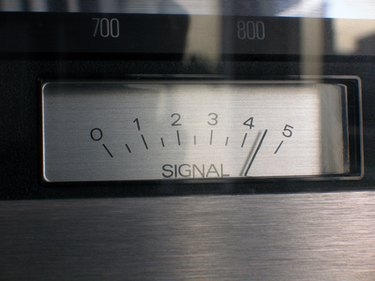
1970s vintage Pioneer receivers are still rattling windows around the world with their warm analog sound and raw power while turning heads with their visually stunning polished silver-and-white aesthetic. Classic audio enthusiasts favor Pioneer units; Ebay.com generally has more vintage Pioneer receivers for auction than any other brand, and a quick review of Ebay's vintage receiver auctions on January of 2011 showed more Pioneer receivers available than the second and third most popular marks (Sansui and Marantz) combined.
The "Silver Era"
Video of the Day
The classic or "Silver" period for Pioneer receivers spanned a decade from approximately 1971-1981. Pioneer receivers from this period are lauded for their sound: a warm, analog feel that remains bright enough to appreciate higher tones or more subtle musical passages. However these units are admired for their looks as well. The term "Silver" refers to the units' overall presentation that features brushed aluminum front panels. These receivers also displayed solid machined aluminum knobs, silver toggle switches and push-buttons and walnut veneers and trim. The visual apex of the Silver Era began in 1976, when Pioneer receivers had a silver-on-silver design with a white tuner background. The end of the Silver Era began in the early 1980s when Pioneer opted to use a digital microprocessor in lieu of analog controls, and culminated in the middle of the decade when they abandoned their silver/metal aesthetic for a black plastic presentation. Vintage audio enthusiasts generally focus on the Silver Era, admiring both the sound and look of this equipment.
Video of the Day
The Classic Pioneer Series
During the silver period Pioneer produced eight series of receivers: the 400 series, rated at 15 watts per channel (WPC) and retailing for approximately $200; the 500 series at 17 WPC and around $250; the 600 series featuring 27 WPC and selling for a little less than $350; the 700 series which drove 40 WPC and sold for close to $400; the 800 series which was rated at 60 WPC and retailed for less than $500; the 900 series which drove 70 WPC and retailed for just under $600; the 1000 series which carried a whopping 120 WPC, retailed for $700 and weighed in at an impressive 51 pounds; and finally the 1200 series which produced a massive 160 WPC, retailed for $900 and tipped the scales at 65 pounds. All of these series are appreciated by vintage audio collectors, particularly the 1200 and the 800 series.
The Silver Pioneer Flagship, the SX-1980
In 1978 Pioneer produced the finest receiver of its Silver Era, the SX-1980. When introduced, the 1980 featured a then-industry high rating of 270 watts per channel. It was largest receiver Pioneer ever built, measuring 22 inches wide, 19 1/2 inches deep and 8 1/4 inches high. It is also the heaviest receiver Pioneer produced, tipping the proverbial scales at 78 pounds. These specifications led to the 1980 being Pioneer's most expensive receiver, retailing for almost $1300. The Pioneer Reference Site describes the 1980's interior design layout as "careful and logical" and refers to it as "the apogee of Pioneer's two-channel stereo receiver development."
An Argument for the SX-850
While the SX-1980 is the largest, most powerful and most expensive receiver Pioneer produced during its Silver Era, it is not for everyone. Audio enthusiasts living in close proximity to others, or with smaller listening spaces, might never have the opportunity to listen to a 1980 at full throat and fully appreciate its capabilities. Such individuals will be better suited by a SX-850 which, again according to the Silver Pioneer Reference Site, "is eagerly sought by collectors and listeners." It has enough power to shake the walls of most rooms at 60 watts per channel and visually presents the classic Pioneer silver-on-silver aesthetic.